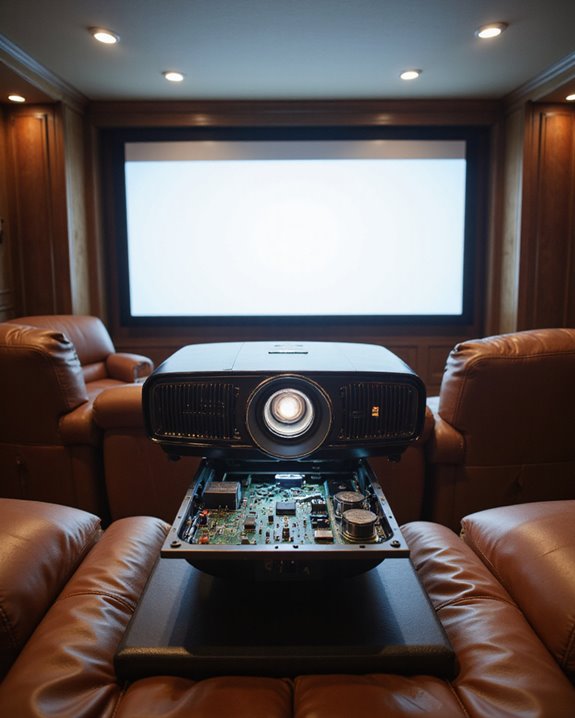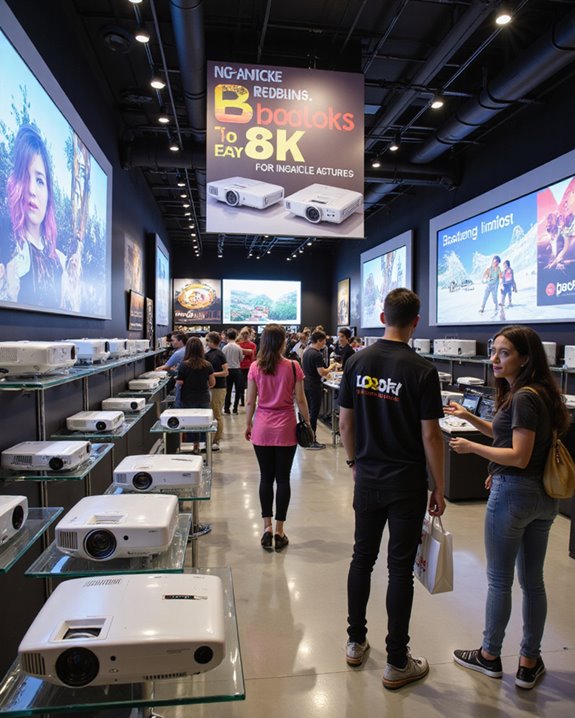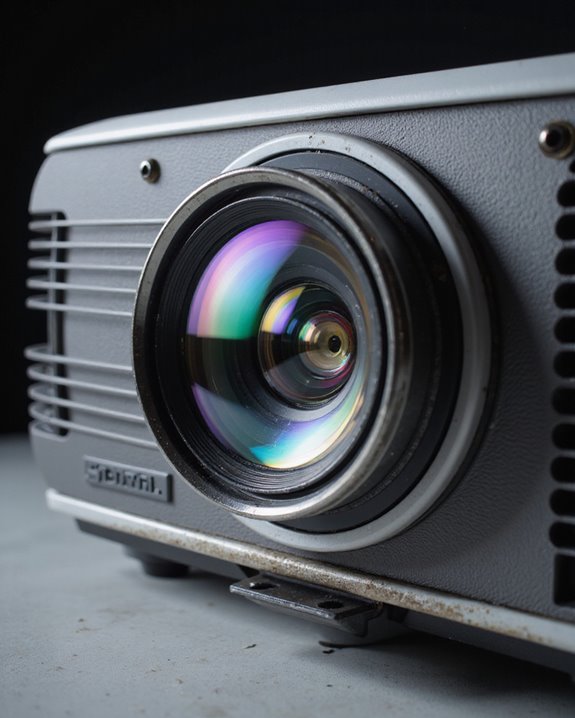Projectors are expensive due to their sophisticated engineering requirements and complex manufacturing processes. High-quality optical components, including specialized lenses and light sources, demand precision production methods. Advanced features like 4K resolution and laser technology require substantial research and development investments. The integration of smart features, environmental compliance standards, and extensive quality control measures further increase costs. Additionally, ongoing maintenance needs and replacement parts contribute to the overall expense. Understanding these factors reveals the true value behind projector pricing.
Key Takeaways
- Advanced display technologies like 4K and laser light sources require sophisticated components and complex manufacturing processes, significantly increasing production costs.
- Extensive research and development investments are necessary for innovation, new features, and maintaining competitive advantage in the projector market.
- Quality optical components demand exceptional precision in manufacturing, specialized equipment, and skilled technicians to produce reliable projection systems.
- Global supply chain complexity, distribution networks, and international trade regulations contribute substantially to overall projector costs.
- Ongoing maintenance requirements, including lamp replacements and quality control measures, influence both manufacturing costs and total ownership expenses.
Advanced Display Technologies Drive Up Manufacturing Costs
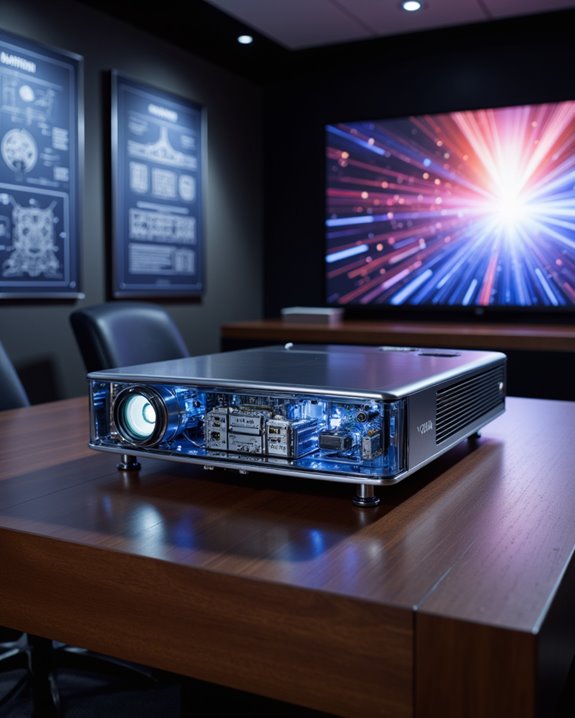
Modern projectors command premium prices largely due to their sophisticated display technologies, which substantially increase manufacturing costs. The complexity of achieving high display resolution, particularly in 4K systems, requires advanced components that drive up production expenses considerably. Additionally, the integration of laser light sources offers enhanced brightness and color accuracy but involves complex manufacturing processes that add to costs. Manufacturers must invest heavily in specialized light source technologies, such as LEDs and lasers, to deliver ideal brightness and color accuracy. These components, combined with sophisticated digital processing systems, contribute to higher costs. Advanced camera-based calibration systems that ensure consistent image quality add another layer of manufacturing complexity. The integration of complex features like DLP (Digital Light Processing) technology, which uses thousands of microscopic mirrors to create images, further adds to the expense.
Additional cost factors include:
- Advanced integrated circuits for signal processing
- Patented technology licensing fees
- High-grade optical components
- Sophisticated color management systems
- Precision manufacturing requirements
The Role of High-Quality Optical Components
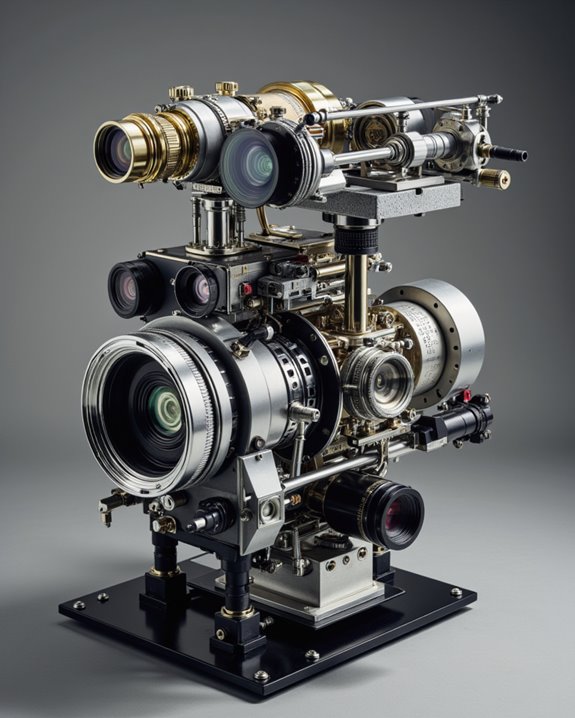
The high-quality optical components in projectors serve as the foundation for creating crisp, clear images on screens. These components require exceptional optical precision in their design and manufacture, often incorporating multiple lens elements that must work together perfectly. Material selection plays a vital role, as high-grade glass or polycarbonate materials are essential for peak performance.
The complexity of projector lenses involves several key aspects:
- Multiple lens elements (typically 3-6 pieces)
- Specialized anti-reflection coatings
- Precise polishing and finishing processes
- Custom designs for specific applications
Manufacturing these components demands sophisticated equipment and skilled technicians, driving up production costs. The need for rigorous quality control and testing further adds to the expense, as even minor imperfections can profoundly impact image quality. Each lens assembly must meet strict tolerances to guarantee consistent performance. Initial development can be particularly costly, with design costs starting at $2000 for basic lens configurations. Additionally, the use of advanced optical coatings enhances image clarity but also increases manufacturing expenses.
Research and Development Investment Impact

Major investments in research and development (R&D) substantially drive up projector costs, with leading manufacturers spending hundreds of millions annually to develop new technologies. Companies like Logitech invest over $287 million in R&D to create advanced features such as 4K resolution, HDR capabilities, and innovative light sources.
These investments extend beyond hardware development, encompassing customer support systems and warranty services that ensure product reliability. The competitive market demands continuous innovation, particularly in emerging technologies like ultra-short throw and interactive projectors. The global projector industry, valued at $11.1 billion in 2024, demonstrates significant investment in technological advancement. Patent costs and intellectual property protection add to the overall expense, while companies must maintain profit margins to sustain their R&D efforts. The projected growth of specialized markets, such as 3D projectors reaching $6.1 billion by 2030, demonstrates how R&D investments shape the industry’s future.
Supply Chain Complexities and Material Expenses
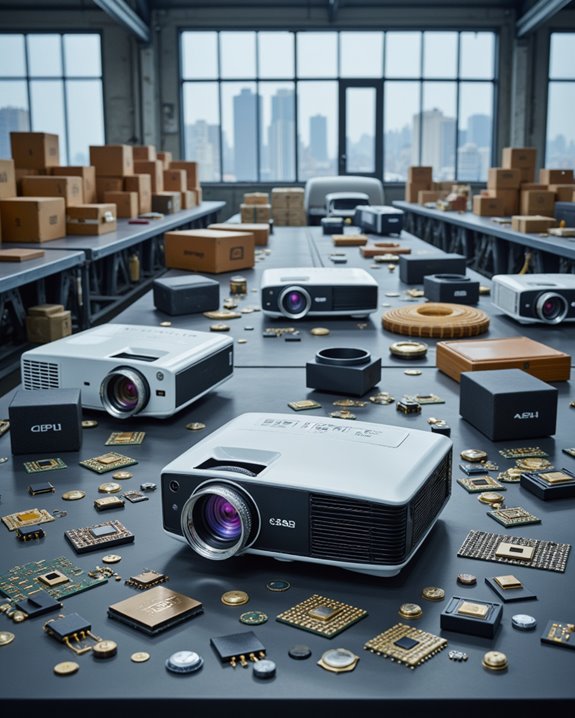
Beyond research and development costs, supply chain intricacies substantially influence projector pricing in today’s market. The lengthy production chain spans multiple continents, involving numerous suppliers and manufacturers who contribute various specialized components. Manufacturers must carefully track their total cost of ownership to maintain profitability while delivering quality products.
Material costs play a significant role in driving up projector prices. Manufacturers must source high-quality raw materials, including specialized plastics, metals, and optical components, whose prices frequently fluctuate in the global market. The need for premium materials to ensure durability and performance further increases expenses. Additionally, supply chain challenges such as:
- Global shipping costs
- Import duties and customs fees
- Inventory management expenses
- Storage and handling requirements
These factors combine with the complexity of coordinating multiple suppliers worldwide, making projectors more expensive to produce and distribute to consumers.
Smart Features and Technology Integration Costs
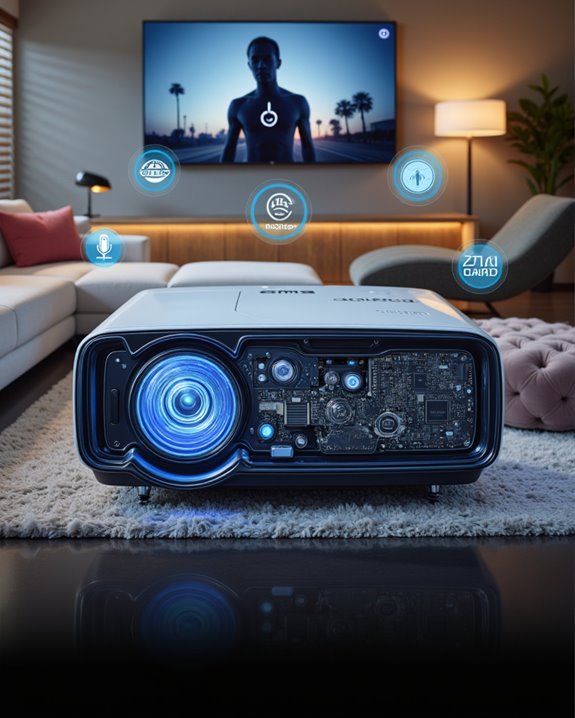
Smart projectors integrate sophisticated technology that significantly drives up manufacturing costs. The inclusion of built-in operating systems allows these devices to function as standalone entertainment hubs with direct streaming capabilities. These advanced projectors require powerful processors and chipsets to handle multiple apps and streaming services simultaneously. Additionally, the implementation of auto-keystone correction and auto-focus features adds to the overall expense. The incorporation of various wireless connectivity options and IoT compatibility further increases production costs, as these components require extensive research and development.
Environmental Compliance and Sustainability Factors
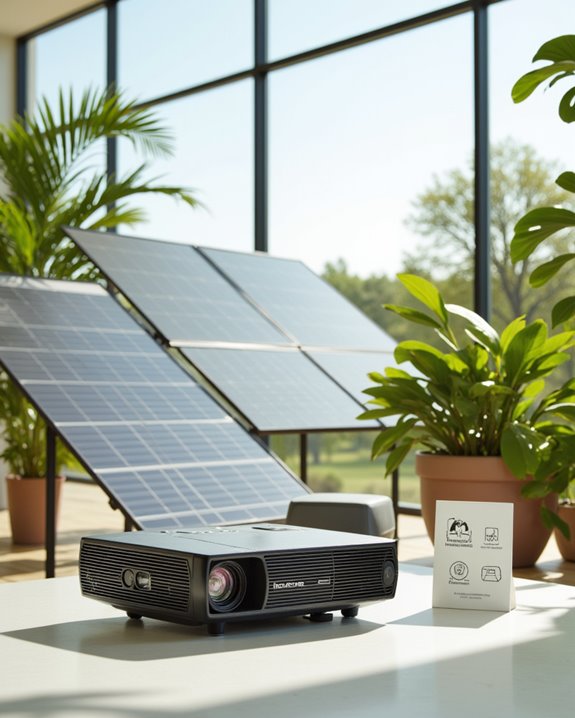
Environmental compliance and sustainability requirements have become significant drivers of projector costs in recent years. Manufacturers must adhere to strict environmental policies, such as the EU’s Directive on Energy-related Products (ErP), which demands specific energy-efficient features and ecological design standards. These regulations often require costly modifications to manufacturing processes and components.
Sustainability initiatives also contribute to higher production expenses. Companies must invest in eco-friendly materials, implement power-saving features, and develop filter-free designs that reduce maintenance waste. Modern projectors incorporating mercury-free SSI technology further increase manufacturing costs while providing environmental benefits. Advanced cooling systems and efficient LED light sources, while better for the environment, typically cost more than traditional components. Additionally, manufacturers face expenses related to environmental certifications, proper e-waste management, and the use of recyclable materials throughout the product lifecycle. These factors collectively impact the final price of projectors.
Market Competition and Pricing Dynamics
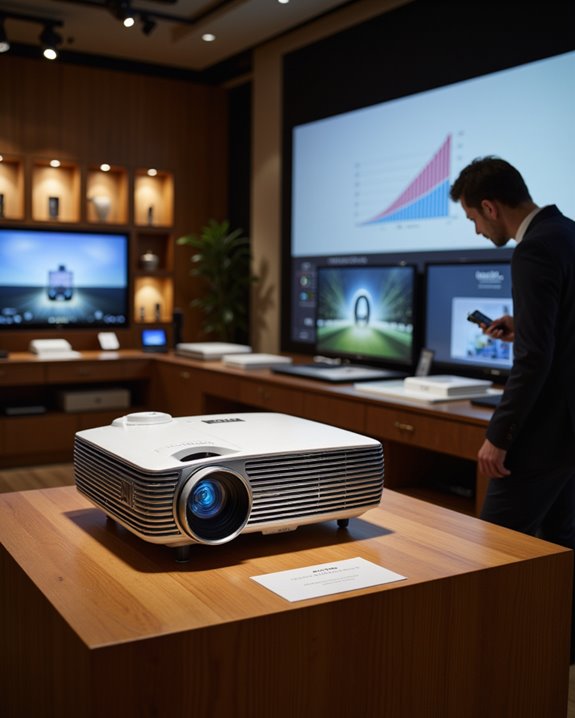
The global projector market operates as a highly competitive arena where multiple manufacturers vie for market dominance through strategic pricing and product differentiation. Market segmentation, the division of consumers into distinct groups based on needs and preferences, drives manufacturers to develop various product tiers with corresponding price points. With high demand in education driving market growth, manufacturers must balance competitive pricing with the need to meet diverse institutional requirements. Companies carefully consider price elasticity, which measures how demand changes with price fluctuations, when positioning their products. Premium features like 4K resolution and laser technology command higher prices, while entry-level models target budget-conscious consumers. The competitive landscape also forces manufacturers to invest heavily in research and development, contributing to overall costs. Strategic partnerships with distributors and service providers further influence pricing structures, as companies work to balance innovation costs with market accessibility. This complex dynamic helps explain why projectors maintain relatively high price points.
Quality Control and Testing Requirements
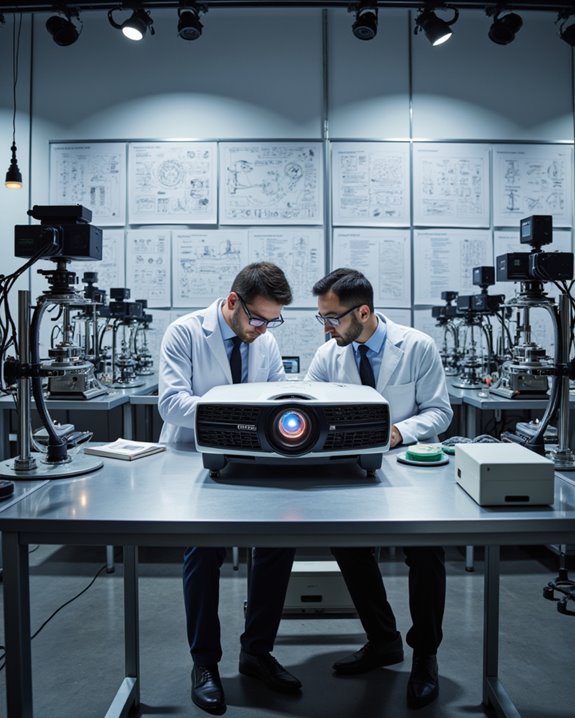
Maintaining reliable performance and meeting industry standards requires projector manufacturers to implement extensive quality control measures throughout production. Component certification processes involve rigorous testing of optical, electronic, and mechanical parts to guarantee safety and functionality. Specialized instruments measure critical factors like color accuracy, brightness uniformity, and contrast ratios.
Measurement calibration procedures are particularly demanding, requiring sophisticated tools and software to verify image quality across multiple parameters. Manufacturers must conduct comprehensive real-time testing using simulation models and automated verification frameworks. Regular inspections must verify that bayonet cable adapters maintain proper threading and squared edges for secure connections. These quality control requirements substantially impact production costs, as they demand:
- High-precision testing equipment
- Regular instrument calibration
- Specialized testing software
- Multiple inspection phases
- Compliance with regulatory standards
These thorough testing protocols help prevent costly recalls while ensuring consumer satisfaction and product reliability.
Branding and Distribution Network Expenses
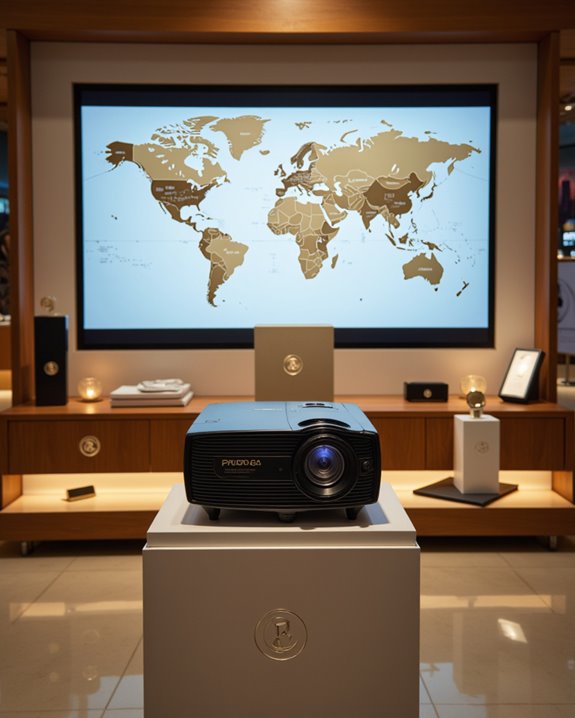
Building strong brands and managing distribution networks represent significant cost factors in projector manufacturing. Companies invest heavily in marketing campaigns and promotional activities to achieve brand differentiation in a competitive market. These expenses include advertising across various media platforms, participating in trade shows, and creating professional digital content to showcase their products. Major industry leaders like Sony and Samsung establish the baseline for premium pricing in the market.
The distribution infrastructure also adds considerable costs. Manufacturers must maintain complex supply chains, establish dealer networks, and manage inventory across multiple locations to ensure product availability. Additionally, companies invest in training their sales force and providing extensive customer support to build customer loyalty. International trade regulations and compliance requirements further increase distribution expenses, as manufacturers must navigate different market requirements and tariffs while maintaining consistent product quality and service standards.
Long-Term Maintenance and Replacement Considerations
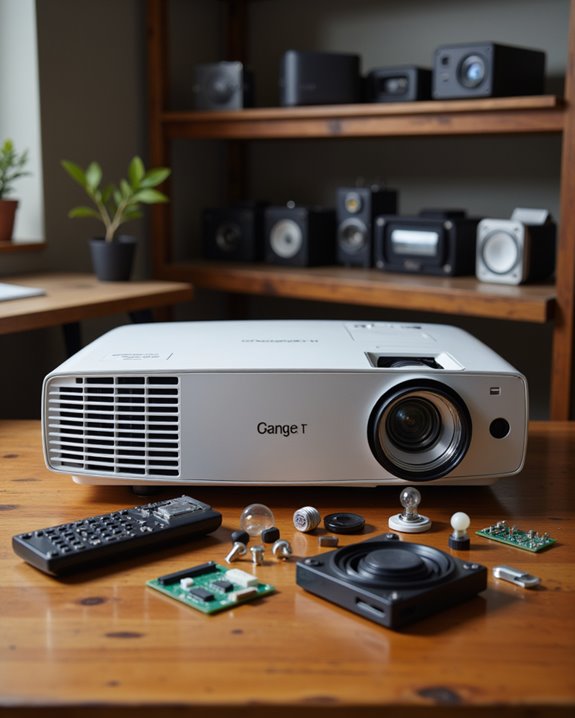
When evaluating projector expenses, long-term maintenance and replacement costs often surpass the initial purchase price, making them crucial factors in the total investment calculation. The projector lamp lifespan typically ranges from 2,000 to 5,000 hours, requiring replacements that cost between £50 and £250, while laser projector lamps can reach £1,000. Using projectors for 3-5 hours daily in clean environments can significantly maximize lamp longevity.
Regular maintenance includes addressing dust accumulation, which can severely impact performance. Effective dust prevention strategies, such as proper installation and high-quality filters, help extend equipment life. However, these solutions add to the overall costs:
- Filter replacements
- Professional cleaning services
- Component repairs
- Warranty coverage
Environmental factors like air quality and temperature also influence maintenance frequency, making it essential to budget for ongoing care throughout the projector’s lifecycle.
Frequently Asked Questions
How Often Should I Replace My Projector’s Lamp?
Like stars fading in the dawn, projector lamps require replacement when their brightness dims considerably. Typical lamp lifespan ranges from 1,500-5,000 hours, with replacement frequency depending on daily usage and environmental conditions.
Can Outdoor Conditions Affect My Projector’s Performance?
Yes, outdoor conditions considerably impact projector performance. Factors like sunlight, humidity, and temperature affect image quality. Outdoor durability and weather resistance are vital considerations when using projectors outside to guarantee peak viewing experience.
Are Refurbished Projectors a Reliable Alternative to New Ones?
Refurbished projectors offer reliable performance when sourced from reputable sellers. With extensive quality control measures and testing protocols in place, they provide significant cost savings while maintaining comparable functionality and warranty coverage to new units.
What’s the Difference Between Short-Throw and Long-Throw Projectors?
Powerful projectors perform differently: Short-throw creates large projection sizes from close distances (3-8 feet), while long-throw requires greater room depth (10+ feet). Each offers distinct installation flexibility based on space requirements.
Do Projectors Consume More Electricity Than Large-Screen TVS?
Projectors typically consume more electricity than large-screen TVs, with power consumption ranging from 150-800 watts compared to TVs’ 80-400 watts. However, projectors offer better energy efficiency when displaying very large images.

